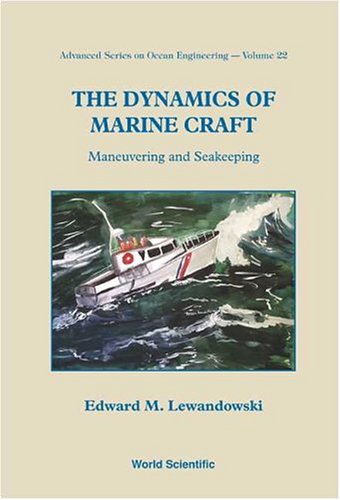Edward M. Lewandowski9810247559, 9789810247553, 9789812562678
Table of contents :
The Dynamics of Marine Craft: Maneuvering and Seakeeping……Page 4
PREFACE……Page 6
CONTENTS……Page 8
1. Coordinate Systems and Definitions……Page 14
2. Angular Displacements and Coordinate Transformations……Page 16
3. Velocity and Acceleration……Page 18
4. Equations of Motion: Origin at the Center of Mass……Page 21
5. Equations of Motion: Origin at an Arbitrary Point……Page 25
6. A Third Coordinate System……Page 27
CHAPTER 2 CALM WATER BEHAVIOR OF MARINE VEHICLES AT ZERO SPEED: HYDROSTATICS……Page 28
1. Gravity and Buoyancy……Page 29
2. Small Perturbations……Page 33
3. The Restoring Force Coefficient Matrix……Page 37
4. Hydrostatic Stability……Page 39
5. Example: Hydrostatics of a Simple Barge……Page 44
1. Equations of Motion……Page 48
2. Added Mass and Added Moment of Inertia……Page 49
2. I Evaluation of added mass coefficients: Hull……Page 53
2.2 Shallow water effects……Page 61
2.3 Evaluation of added mass coefficients: Appendages……Page 63
2.4 Calculation of added mass: Example……Page 64
3. “Steady” Forces and Moments……Page 67
4. Evaluation of Steady Force and Moment Coefficients: Hull……Page 76
4.1 Linear coefficients……Page 77
4.2 Nonlinear coefficients……Page 82
5. Contribution of Appendages……Page 84
6. Shallow Water Effects……Page 90
7.1 Resistance……Page 92
7.2 Thrust……Page 96
7.3 Propeller shaft speed……Page 101
7.4 Other operating regions……Page 102
7.5 Waterjets……Page 103
8. Control Forces and Moments……Page 104
8.1 Rudders……Page 105
8.2 Propeller-Rudder-Hull interaction……Page 107
8.3 Vectored thrust……Page 108
8.3.1 Azimuthing thrusters……Page 109
8.4 Control forces and moments……Page 110
9. Wind and Current Effects……Page 112
9.2 Current……Page 113
10.1 General case: Numerical integration……Page 114
10.2 Solution of the linearized equations; stability……Page 121
10.2.1 Horizontal-plane motions……Page 123
10.2.2 Example: Controls-fixed stability for horizontal-plane motions……Page 128
10.2.3 Vertical-plane motions of submersibles……Page 131
10.2.4 Example: Controls-fixed directional stability for vertical-plane motions……Page 134
10.2.5 Heavy torpedoes……Page 140
APPENDIX A PREDICTION OF WAKE FRACTION AND THRUST DEDUCTION……Page 144
APPENDIX B COEFFICIENTS IN KT and & KQ POLYNOMIALS……Page 148
APPENDIX C ROUTH-HURWITZ STABILITY CRITERION……Page 150
1. A Simple Sinusoidal Wave……Page 152
1.1 Particle velocities and trajectories; dynamic pressure……Page 159
1.2 Standing waves……Page 161
1.3 Group velocity and wave energy……Page 162
1.4 Application: Wave shoaling……Page 165
2.1 Some analytical solutions……Page 167
2.2 Morison’s formula……Page 172
3.1 Stokes theory……Page 176
3.2 Limitations of Stokes theory……Page 179
3.3 Wave breaking……Page 180
4. Spectral Representation of Ocean Waves……Page 181
4.1.1 Wave spectra fiom measurements……Page 183
4.1.2 Semi-empirical formulations of wave spectra……Page 185
4.1.3 Statistics of wave heights……Page 187
4.2 Representation in the time domain……Page 199
5.1 Maximum waveheight from occurrence data……Page 200
5.2 Maximum significant waveheight from extreme value distributions……Page 202
5.2.1 Weibull distribution……Page 203
5.2.2 Gumbel distribution……Page 206
5.2.3 Example……Page 207
1. Wave-Induced Motions: Linear Theory……Page 212
1.1 Hydrodynamic forces: Superposition……Page 215
1.2 Equations of motion; simple 1-DOF case……Page 217
2.1 General computational procedure, zero speed……Page 222
2.2 Two-dimensional methods……Page 225
2.3 Frequency dependence……Page 226
2.4 Added mass and damping forces……Page 228
2.5 Radiation forces in the time domain……Page 232
2.6.1 General case……Page 235
2.6.2 Slender bodies……Page 241
2.7 Transformation to “standard” body axes……Page 247
2.8 Radiation forces: Available data……Page 250
3.1 Radiation forces: Available data……Page 251
3.2 Frequency dependence……Page 261
3.3 The Haskind relations……Page 262
3.4 Exciting forces in the time domain……Page 264
3.5.1 Encounter frequency and encounter spectra……Page 265
3.5.2 Froude-Krylov force with forward speed……Page 268
3.5.3 Diffraction force with forward speed……Page 269
3.6 Transformation to “standard” body axes……Page 277
4.1 Experimental determination……Page 278
4.1.1 General single degree-of-freedom response……Page 284
4.2 Prediction of roll damping……Page 287
4.3 Equivalent linear roll damping……Page 289
5.1 Heaving and pitching in head seas……Page 291
5.2 Rolling in beam seas……Page 299
6.1 Passive devices……Page 304
6.2 Active devices……Page 309
7. Motions in Irregular Waves, Frequency Domain……Page 311
7.1 Encounter spectra……Page 314
7.2 Statistics of maxima……Page 319
7.3 Caveats……Page 323
8.1 Motions at a point……Page 325
8.2 Relative motions……Page 327
8.3 Slamming……Page 331
8.4 Shear force and bending moment……Page 332
8.5.1 Motion sickness and fatigue-reduced proficiency……Page 333
8.5.2 Motion induced interruptions……Page 337
8.6 Operability criteria……Page 338
9. Some Nonlinear Effects……Page 339
9.1 Evaluation of second order force: Pressure integration……Page 340
9.2 Evaluation of second order force: Momentum conservation……Page 345
9.3 Newman’s approximation……Page 351
9.4.1 Wave-drift damping……Page 353
9.4.2 Added resistance……Page 355
10. Mooring Systems……Page 356
10.1 Static catenary line……Page 357
10.1.1 A simple example……Page 361
10.2 Stability of a towed or moored ship……Page 363
1.1 Transverse/directional stability, general……Page 374
1.2 Trunsverse/directional stability, planing boats……Page 379
1.2.1 Dynamic roll moment……Page 380
1.2.2 Dynamic stability; effect of appendages……Page 388
1.3 Heave / pitch stability……Page 393
1.4 Turning performance……Page 395
2. Seakeeping……Page 396
2.1 Impact accelerations……Page 397
2.2 Application: Habitability……Page 401
2.3 Bottom pressure……Page 407
3. Concluding Remarks……Page 408
REFERENCES……Page 410
INDEX……Page 422

Reviews
There are no reviews yet.